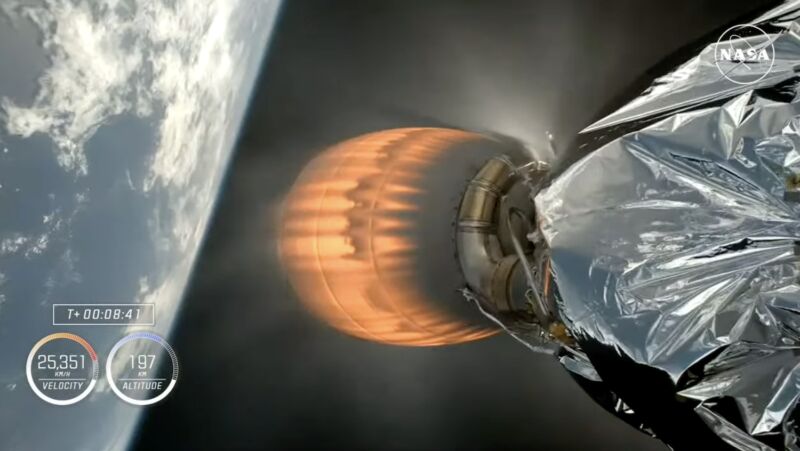
NASA/SpaceX
SpaceX is investigating a problem with the Falcon 9 rocket’s upper stage that caused it to reenter the atmosphere and fall into the sea outside of its intended disposal area after a Saturday launch with a two-man crew heading to the International Space Station.
The upper stage malfunction apparently occurred after the Falcon 9 successfully deployed SpaceX’s Crew Dragon spacecraft carrying NASA astronaut Nick Hague and Russian cosmonaut Aleksandr Gorbunov on SpaceX’s Crew-9 mission. Hague and Gorbunov safely arrived at the space station Sunday to begin a five-month stay at the orbiting research complex.
The Falcon 9’s second stage Merlin vacuum engine fired for more than six minutes to place the Crew Dragon spacecraft into orbit after liftoff from Cape Canaveral Space Force Station, Florida. The engine was supposed to reignite later to steer the upper stage on a trajectory back into Earth’s atmosphere for disposal over the South Pacific Ocean, ensuring the rocket doesn’t remain in orbit as a piece of space junk.
“After today’s successful launch of Crew-9, Falcon 9’s second stage was disposed in the ocean as planned, but experienced an off-nominal deorbit burn,” SpaceX posted on X late Saturday night. “As a result, the second stage safely landed in the ocean, but outside of the targeted area. We will resume launching after we better understand root cause.”
Safety warnings issued to mariners and pilots before the launch indicated the Falcon 9’s upper stage was supposed to fall somewhere in a narrow band stretching from southwest to northeast in the South Pacific east of New Zealand. Most of the rocket was expected to burn up during reentry, but SpaceX targets a remote part of the ocean for disposal because some debris was likely to survive and reach the sea.
SpaceX didn’t release any more details on the upper stage malfunction. Jonathan McDowell, an astrophysicist and expert on spaceflight activity, wrote on X that the most likely failure mode that would still result in a reentry is a “slight underburn” of the Merlin vacuum engine. This would result in the rocket going off course and reentering somewhere over the Pacific Ocean farther downrange, northeast of the projected disposal area.
Third time in three months
This is the third time SpaceX has grounded the Falcon 9 rocket in less than three months, ending a remarkable run of flawless launches.
SpaceX’s upper stage failed during the July 11 launch of a batch of 20 Starlink Internet satellites, stranding the payloads in a lower-than-planned orbit that caused them to reenter the atmosphere and burn up. This was the first mission failure for a Falcon 9 rocket in 335 missions since 2016, a record unmatched in the history of space launch vehicles.
Engineers traced the problem to a crack in a “sense line” for a pressure sensor attached to the vehicle’s liquid oxygen system, resulting in a liquid oxygen leak that prevented the rocket from completing the second burn of its upper stage engine. While Saturday’s upper stage issue is still under investigation, it also arose on the second burn of the Merlin vacuum engine.




















+ There are no comments
Add yours